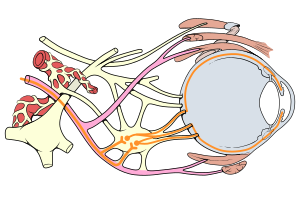Oculomotor nerve palsy
| Oculomotor nerve palsy | |
|---|---|
 |
|
| Eye nerves diagram | |
| Classification and external resources | |
| Specialty | ophthalmology |
| ICD-10 | H49.0 |
| ICD-9-CM | 378.52 |
| DiseasesDB | 2861 |
| eMedicine | oph/183 |
| MeSH | D015840 |
Oculomotor nerve palsy or third nerve palsy is an eye condition resulting from damage to the third cranial nerve or a branch thereof. As the name suggests, the oculomotor nerve supplies the majority of the muscles controlling eye movements. Thus, damage to this nerve will result in the affected individual being unable to move his or her eye normally. In addition, the nerve also supplies the upper eyelid muscle (levator palpebrae superioris) and the muscles responsible for pupil constriction (sphincter pupillae) . The limitations of eye movements resulting from the condition are generally so severe that the affected individual is unable to maintain normal alignment of their eyes when looking straight ahead, leading to strabismus and, as a consequence, double vision (diplopia).
It is also known as "oculomotor neuropathy".
A complete oculomotor nerve palsy will result in a characteristic down and out position in the affected eye. The eye will be displaced outward and displaced downward; outward because the lateral rectus (innervated by the sixth cranial nerve) maintains muscle tone in comparison to the paralyzed medial rectus. The eye will be displaced downward, because the superior oblique (innervated by the fourth cranial or trochlear nerve), is unantagonized by the paralyzed superior rectus, inferior rectus and inferior oblique. The affected individual will also have a ptosis, or drooping of the eyelid, and mydriasis (pupil dilation).
It should be borne in mind, however, that the branched structure of the oculomotor nerve means that damage sustained at different points along its pathway, or damage caused in different ways (compression versus loss of blood supply, for example), will result in different muscle groups or, indeed, different individual muscles being affected, thus producing different presentation patterns.
...
Wikipedia
